New York Bagel Recipe
As an amazon associate I earn from qualifying purchases.
Craving a crusty, chewy bagel? Look no further! This New York bagel recipe rivals anything you can find in Manhattan! No specialty ingredients needed.
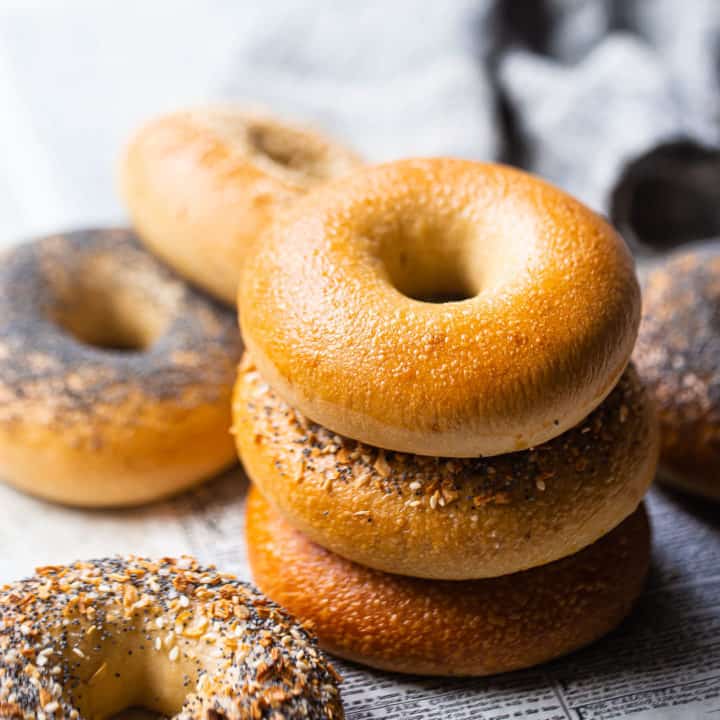
Over the last few months, my crusty French baguette recipe has been one of the top recipes on this site, with easy homemade croissants and soft whole wheat bread coming in close behind.
Hey, I’m no dummy! I can see what all this means: you guys are craving homemade bread!
And I don’t blame you. Carbs are one of life’s greatest pleasures, and they’re even better when they’re fresh from your home kitchen.
So today, I’m thrilled to be sharing this incredible New York bagel recipe.
Have you ever had a New York bagel? New York is famous for its bagels. They are chewy and flavorful, with a blistery, crusty exterior. They’re soft and yeasty in the middle, and they taste so good with cream cheese and all the fixin’s (more on that below!). Next time you’re there, be sure to grab one for breakfast, with a nice, tall, cup of hot coffee. It’s pure bliss!
But if you can’t get to NYC any time soon (thanks a lot, travel ban), don’t fret. This homemade bagel recipe is every bit as good. You can make it from ingredients you probably already have in your pantry, it’s not at all difficult, and it’s a fun way to spend an afternoon.
Even better, the next day you’ll have freshly baked bagels coming out of your oven! And you won’t believe how great these taste.
INGREDIENTS FOR HOMEMADE BAGELS
There are a lot of recipes out there that call for weird specialty ingredients like diastatic malt powder, high-gluten flour, and barley syrup. You won’t find any of that in this bagel recipe. I wanted to make this easy, so anyone who’s not a professional baker can feel comfortable making bagels.
- Water
- Honey
- Yeast
- Flour
- Salt
You’ll also need a little cornmeal to dust your pans, some water and baking soda for boiling, whatever toppings you want to sprinkle on, and a little egg wash to help them stick.
Pretty simple, right?
YEAST
When I make any kind of bread, I use active dry yeast. But I know it’s been hard to get these last few months, so know that if you can’t find it, it’s fine to substitute with the same amount of instant yeast.
If you’d like to use sourdough starter in place of the yeast, use 1 cup of starter and subtract 1/2 cup of water and 3/4 cup of flour to compensate for the water and flour in the starter (source: How to Convert Recipes to Sourdough).
If you’d like to use fresh yeast instead of dry, you’ll need about 0.6 ounces for this bagel recipe.
FLOUR
The higher the protein level in your flour, the chewier your bagels will come out. Many bakers reach for bread flour for recipes like this one, and it’s a great choice since it’s got around 3 to 4% more protein than all-purpose. This results in stronger, more developed gluten structure and a really satisfying texture.
And a lot of commercial bakeries and restaurants use high-gluten flour for bagels, which is even higher in protein.
But again, it’s not always easy to get these types of specialty ingredients. I have not been able to find bread flour on my grocery store shelves for months.
The good news is, you can totally make homemade bagels with all-purpose flour. It works beautifully, especially if you just give it a little extra love when you’re kneading, to make up for the slightly lower protein content. No worries at all!
The bagels you see in these pics were made with ap flour and they came out fantastic! Better than what you can buy at the store, by a mile!
HOW TO MAKE THIS NEW YORK BAGEL RECIPE
Making this dough and shaping it is fun and simple. The bagel recipe as a whole takes a long time, but most of that is resting time while things slow-ferment in the fridge. You’ll only need about a half-hour to make the dough, and another half-hour or so to boil, top, and bake the bagels.
THE DOUGH
Start by mixing cool water with a little honey, so that the yeast has something to snack on. If you don’t have honey, you can use sugar, brown sugar, or whatever kind of syrup/nectar you like (maple, coconut, agave).
Now sprinkle the yeast on top and allow it to dissolve.
After about 5 or 10 minutes, you should see that the mixture is starting to look foamy. This is how you know it’s alive and it will work to get your dough rising. If it doesn’t foam up, it’s probably dead and you should start over.
Once you see the little bubbles, go ahead and start working in the flour.
At first, the dough will seem very dry, almost like it can’t handle all the flour. That’s ok! That’s how it’s supposed to look. It will start out shaggy/scrappy, but the more you work it, the more it comes together.
After a little while, you’ll have a smooth ball like this:
It should be very stiff and not sticky at all. If your dough is sticky, add more flour. You can also add the salt at this point.
Now it’s time to knead. Kneading develops the glutens, and this is what creates that incredible, chewy texture.
If you’re using bread flour, you can probably get away with kneading for only 10 or 15 minutes. If you’re using all-purpose, it will most likely need more like 15 or 20.
You’ll know you’re done kneading when the dough passes the windowpane test: Pinch off a little piece of dough and using your fingertips, stretch it gently from the center outward. You should be able to pull it tissue-thin without it tearing. It should be so thin you can see light passing through it, just like a windowpane.
FORMING THE BAGELS
Now divide your dough into 8 equal portions. I like to use a digital kitchen scale for this step, so all my bagels come out exactly the same size. If you don’t already have one, you can order one here: Kitchen Scale.
Roll each portion into a tight, smooth ball, keeping the rest of the dough covered with plastic wrap or a damp towel while you’re working, so it doesn’t dry out.
Then, push your thumb into the center of the ball to make a small hole.
Use your fingers to stretch the hole bigger and form the bagel shape. You’ll want to make your hole a little larger than what seems necessary, because as the dough rises your hole will shrink.
RESTING THE DOUGH
Place your unbaked bagels on a baking sheet that’s been lined with parchment and dusted heavily with cornmeal. This is to prevent sticking.
Tent them with foil that’s been lightly misted with non-stick cooking spray, and stash them in the fridge for 12 to 18 hours.
Yes, that’s right! A long, slow nap at a cool temp will allow the flavors to really develop. This is called “retarding,” and it slows down the yeast fermentation, allowing the natural bacterias to produce acids that give the bagels a more complex flavor, and allow those signature “fish eyes” (aka: tiny blisters on the surface) to form.
I would recommend doing everything up to this point in the late afternoon/early evening. That way, you can wake up and finish baking your bagels first thing in the morning.
BOILING THE BAGELS
After all that time resting, your unbaked bagels should look a lot bigger the next morning.
The next step is to preheat the oven and boil them. Use a LOT of water (I like to do this step in a stockpot or Dutch oven), and add a little honey and baking soda to help create that gorgeous golden brown sheen.
Drop each bagel (one at a time) into rapidly boiling water, and allow it to simmer there for about 20 seconds on each side. Then scoop them out with a strainer and drain them on a wire rack.
BAGEL TOPPINGS
Everything bagels are my favorite. You can buy everything bagel seasoning already made or you can make your own.
- Sesame Seeds
- Poppy Seeds
- Dehydrated Minced Onion
- Coarse Salt (like kosher salt or sea salt
… then you can make your own everything bagel seasoning. Just mix about 2 tablespoons of each of these ingredients in a small bowl and there you have it.
Egg wash is optional, but I really think it makes these bagels extra-pretty. It gives them a glossy look, and allows them to become deeply golden-brown as they bake.
If you’re using egg wash, brush it on before adding your toppings. If not, just sprinkle the toppings right on the boiled bagels. They will feel a little sticky from the boil and the toppings will adhere beautifully.
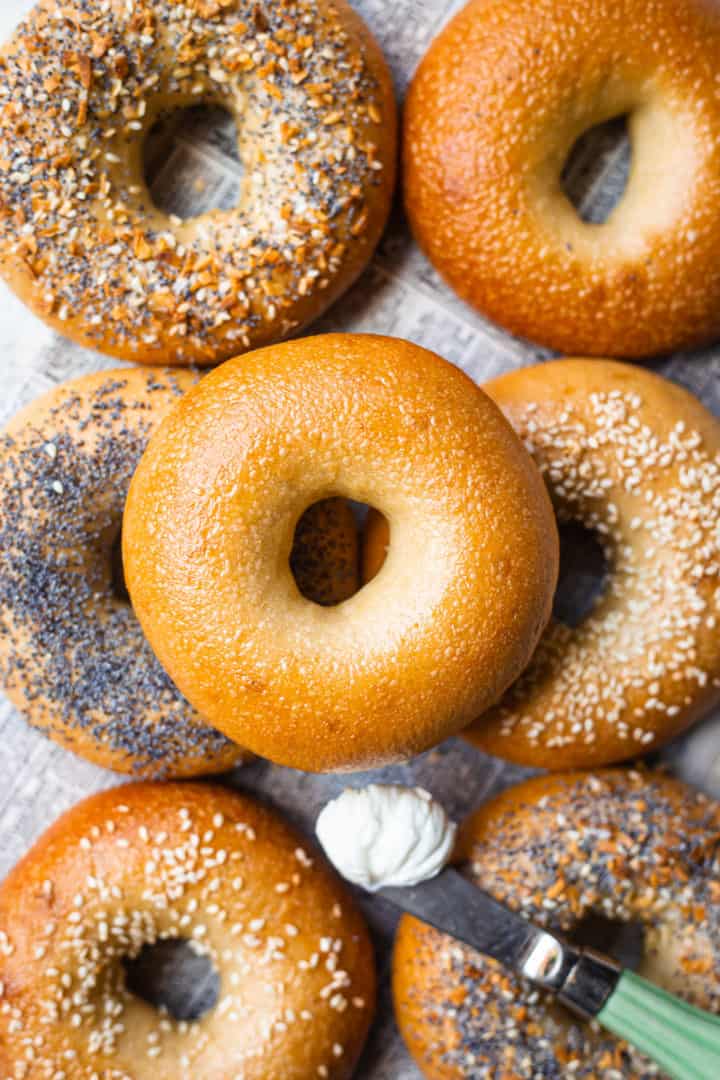
BAKING THE BAGELS
These will bake at a pretty high temperature until deep golden brown, shiny, and blistery on top.
This usually takes anywhere from 12 to 18 minutes, just as a rough guideline. Remember that no two ovens are exactly the same, so rely more on those visual cues than a number you see on a recipe card.
HOW TO SERVE BAGELS
There are so many delicious ways to enjoy a bagel! I especially love them split horizontally, toasted, and topped with cream cheese and a slice of fresh tomato. But really, the sky is the limit!
- Butter
- Cream cheese
- Smoked salmon, aka: lox
- Thinly sliced red onion
- Capers
- Fresh dill
- Thinly sliced tomato
- Fresh sliced cucumber
- Fresh sliced avocado
- Scrambled or fried egg
- Bacon, sausage, or ham
- Any kind of cheese
- Peanut butter or almond butter
- Honey
You could also make pizza bagels! These are always a big hit. Just spread on a little pizza sauce and add shredded mozzarella and pepperoni slices, then pop them into the oven until melty and delish.
CAN THE DOUGH BE MADE AHEAD
You can make this dough, shape the bagels, and freeze them on a tray. Once they’re frozen solid, transfer them to a zip-top freezer bag and they will be good in the freezer for 2 weeks.
When you’re ready to bake them, place them on a parchment-lined, cornmeal-dusted tray (covered) in the fridge and allow them to thaw and slow-ferment as usual, then continue on with the recipe from there.
HOW TO STORE HOMEMADE BAGELS
Once they’re fully cooled, slip your bagels into an airtight bag and they will last at room temperature for a few days. After that, pop them into the fridge and they should keep for about a week or two.
CAN YOU FREEZE BAGELS?
Homemade bagels, like most breads, freeze beautifully. If wrapped tightly, you can expect your bagels to last for up to 2 months in the freezer. Thaw them at room temp or in the fridge before serving.
A FEW MORE OF MY BEST YEAST BREAD RECIPES:
As an amazon associate I earn from qualifying purchases.

New York Bagel Recipe
Ingredients
- 1 1/4 cups (295.74 g) cool water , (around 80 degrees F)
- 2 tablespoons (29.57 g) honey,, divided
- 1 packet (7 g) active dry yeast* , (1/4 ounce or about 2 teaspoons)
- 4 cups (500 g) flour , (bread flour OR all-purpose flour; approximately, you may need slightly more)
- 2 teaspoons (9.86 g) kosher salt
- cornmeal, (for dusting the pans)
- 1 1/2 gallons (5678.11 g) water
- 1 tablespoon (14.79 g) baking soda
- egg wash, (one large egg beaten with a few teaspoons of cool water)
- sesame seeds, poppy seeds, dehydrated minced onion, and/or coarse salt, (optional garnish)
Instructions
- Place the cool water in a large bowl and stir in 1 tablespoon of honey.
- Sprinkle the yeast on top and allow it to dissolve. (After about 5 to 10 minutes, the mixture should start to look foamy.)
- Stir in the flour, mixing until a stiff, shaggy dough forms.
- Add the salt, and knead the dough until it gathers into a ball and becomes smooth and elastic.
- Continue kneading the dough until it passes the windowpane test** (about 15 to 20 minutes).
- Divide the dough into 8 equal portions, rolling each one into a smooth ball. (Cover the dough as you're working so it doesn't dry out.)
- Place each ball of dough on a parchment-lined baking sheet that's been generously dusted with cornmeal, cover, and allow to rest for 5 minutes.
- Using a thumb or finger, poke a hole into the center of each ball of dough, then stretch the hole wider to form the bagel shape.
- Place the shaped bagels back onto cornmeal-dusted, parchment-lined baking sheets, tent with lightly greased foil, and refrigerate for 12 to 18 hours.
- Preheat the oven to 450 degrees F, bring the water to a rapid boil, and add the remaining honey and the baking soda (the water will foam up briefly).
- Gently place the bagels in the hot water, allowing them to boil for 20 seconds on each side.
- Carefully remove the bagels from the hot water with a spider or slotted spoon, allowing them to drain on a wire rack.
- Transfer the bagels to a baking sheet that's been lined with lightly greased parchment paper.
- Brush them lightly with egg wash and sprinkle on toppings (if using), then bake until golden brown and blistered (approximately 12 to 18 minutes).

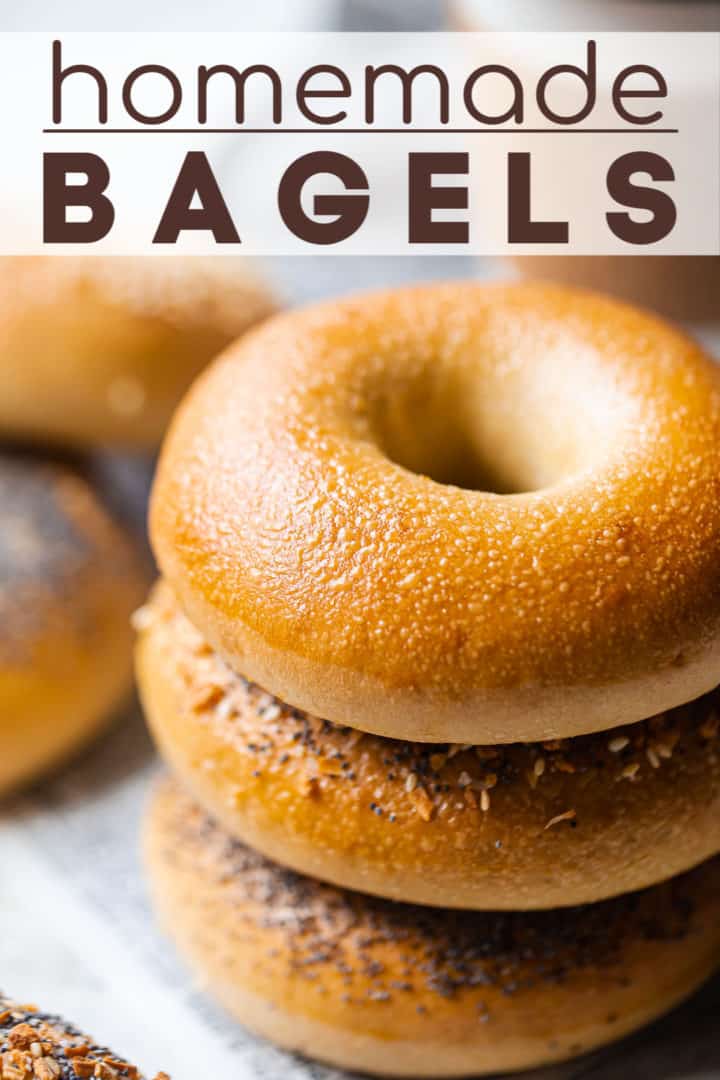
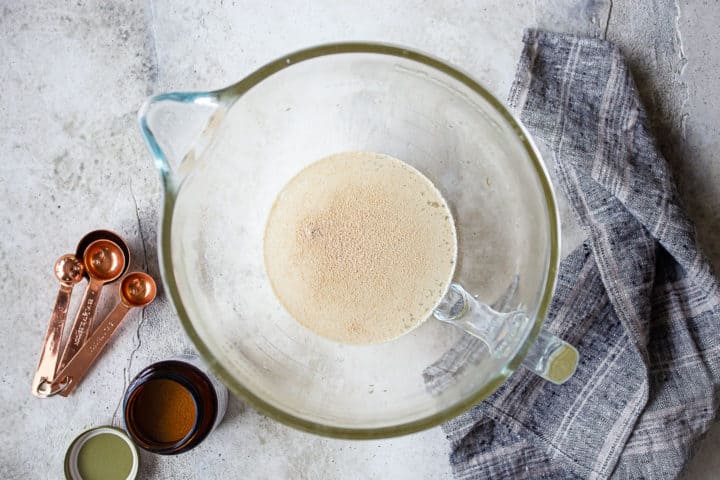
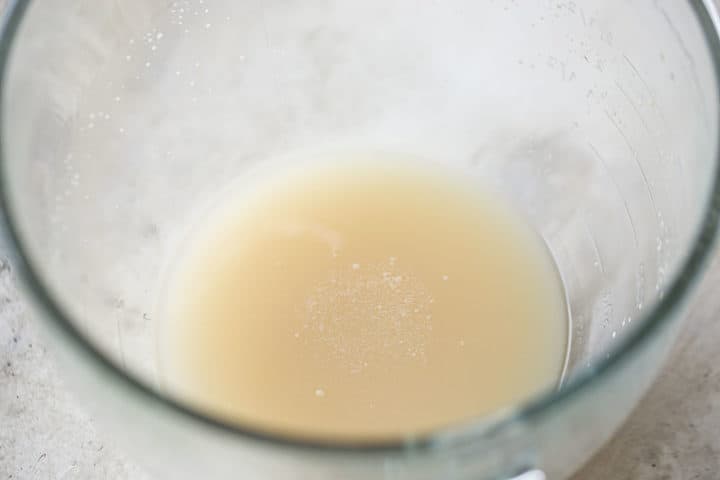
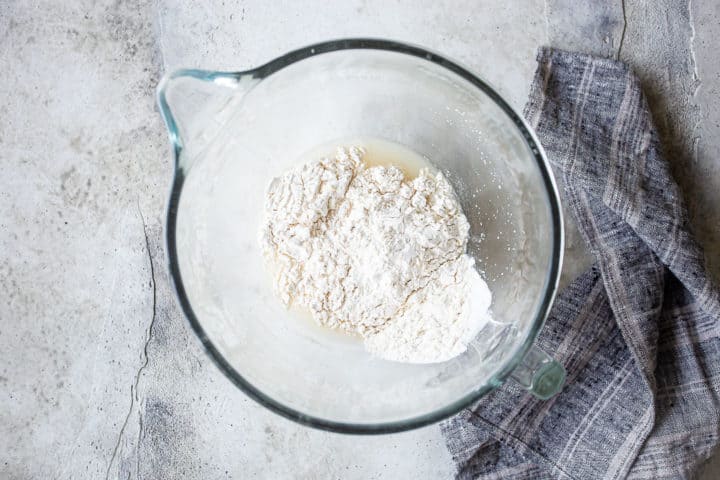


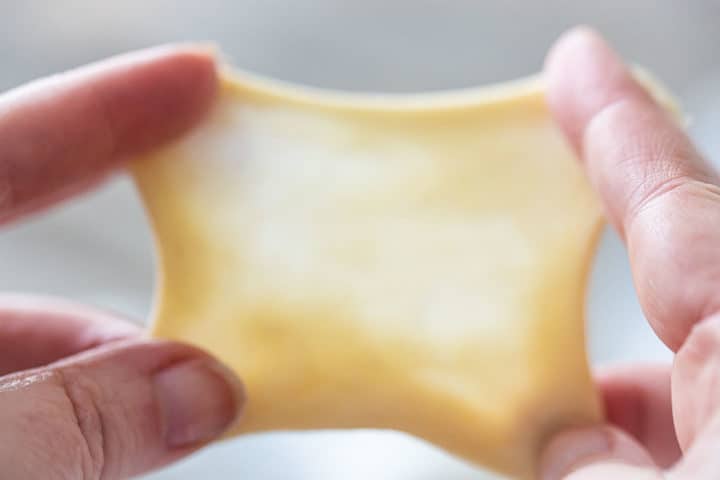
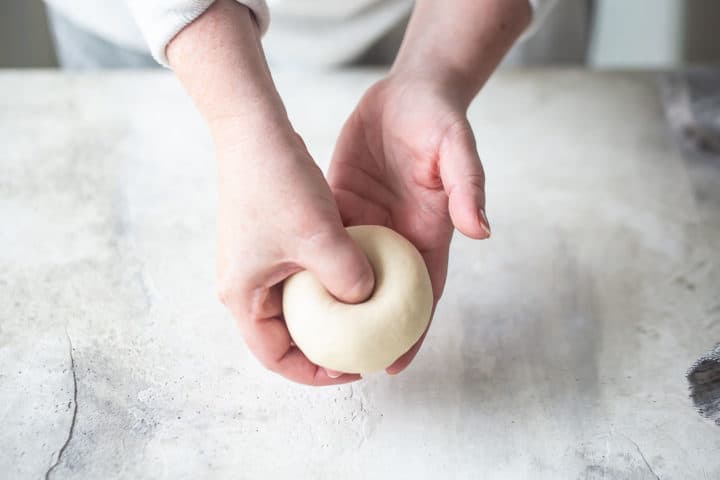

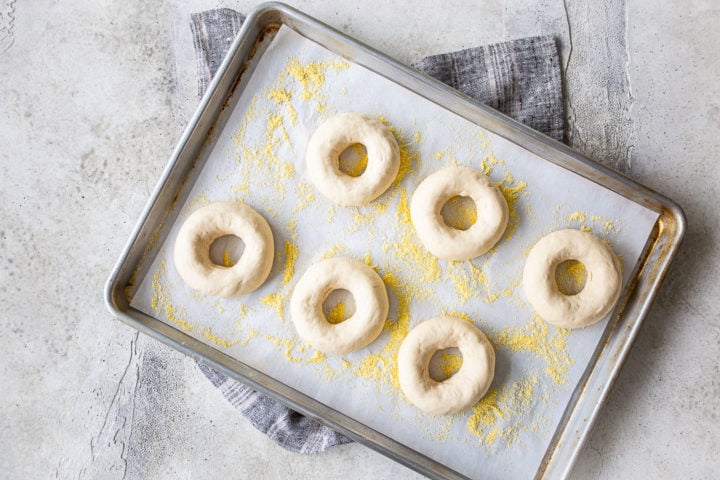

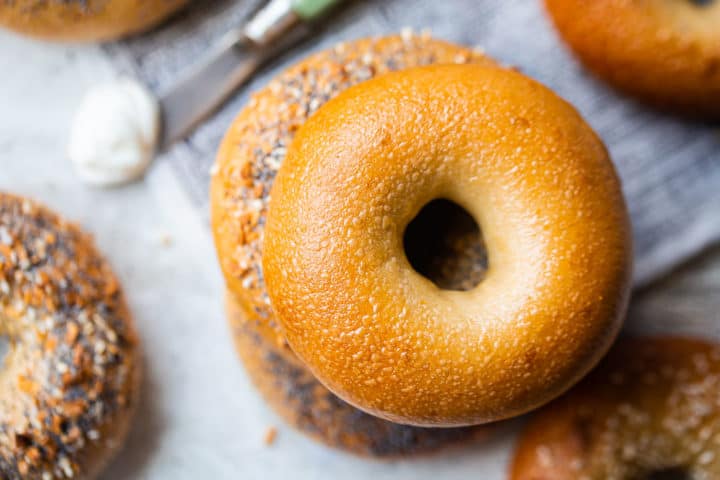


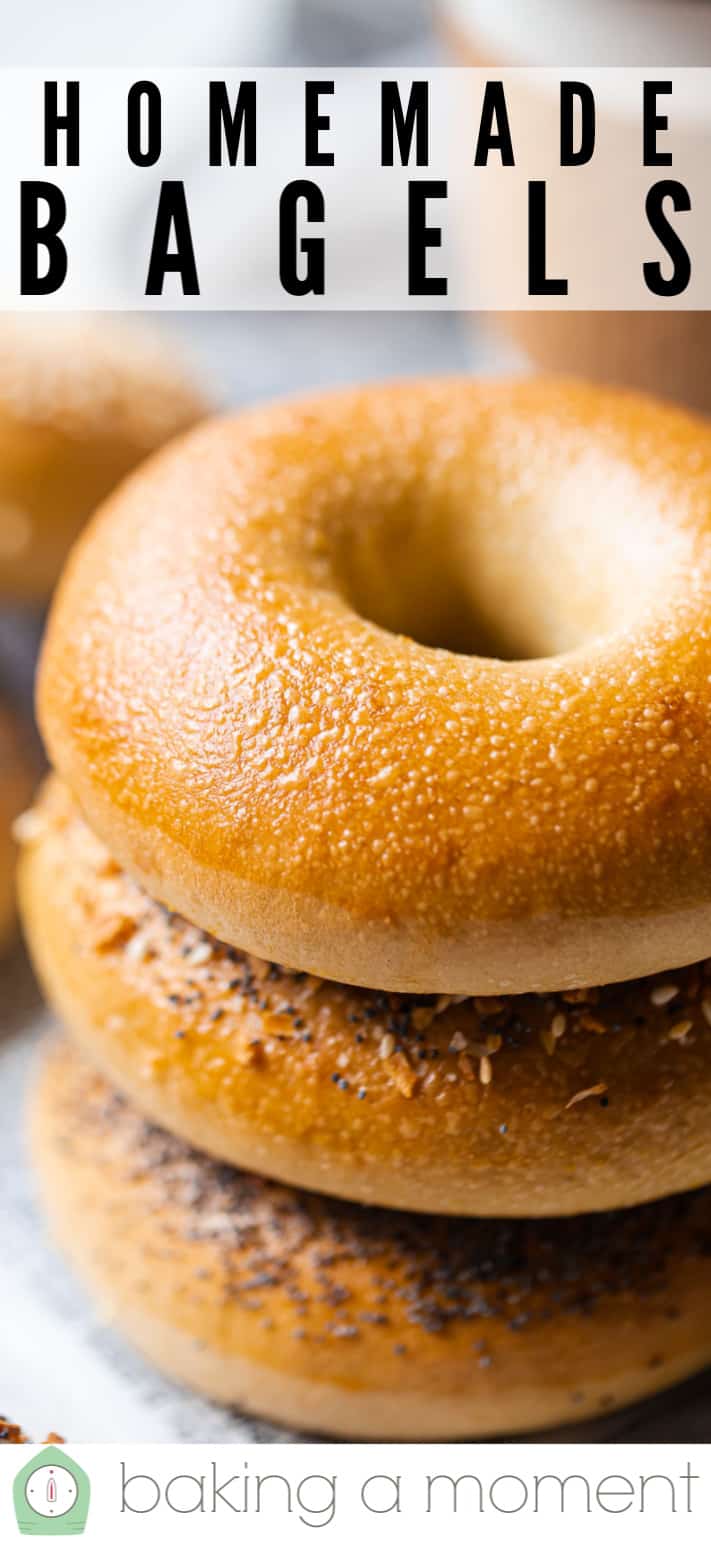











Is the water amount correct? I find it difficult to imagine 4 cups of flour needing 1.5 GALLONS of water to make a stif dough.
Go back and read the recipe instructions dear! It’s 1 1/4 cups of cool water in the dough and another 1 1/2 gallons for boiling the bagels. Hopefully this clears things up for you!
Honestly fool proof. Absolutely delicious. I think next time I’ll split the dough to make 6 bagels instead of 8 just because I prefer a bigger bagel. Thanks so much for the recipe it’s going to be a family staple!
My pleasure Katie! So glad you were happy with it!
Hi there! I’m trying this recipe out for the first time and I’m worried that they aren’t getting any bigger even after 12 hrs in the fridge. How much bigger should they be before the boiling and baking stage? Really hoping I got it right 🤞🏼😅 TIA
Hey there! I’m so happy you’re giving this recipe a try. I think it might help if you have a look at the photo that’s right under the heading “Resting the Dough.” This is what the bagels look like just after they’ve been formed. Then, scroll down to just under the heading “Boiling the Bagels.” This is what they should look like after they’ve risen. They’re just a little chubbier. These two pics should give you an idea of what to expect. Good luck!
I think for anyone having the dry, dense issue perhaps you need to scoop, pour and level your flour into the measuring cup. Do not use your measuring cup to scoop the flour as it packs it in. ALL flour for any recipe measured should have the scoop, pour, level method or weight it. You can get up to a 1/2 C or more flour than you need if it’s not measured correctly.
Couldn’t agree more! That’s exactly why I wrotes this guide: https://bakingamoment.com/how-to-measure-ingredients-for-baking/.
Wonderful recipe. I’ve made them 3x and perfect everytime.
Awesome! TYSM for the positive feedback!
Mine turned out dense. The dough was tough to work with – on the dry side. What did I do wrong?
Sounds like maybe you could have used a little less flour? Bread baking isn’t an exact science, unfortunately! It can be frustrating. Depending a lot on weather conditions, you may need more or less flour. You really have to pay attention to those sensory cues: look for the shaggy stage, when it’s no longer sticky that’s when to stop adding flour, and then knead it smooth. Be sure to knead it for a good long time, this will help with the texture. And same goes for the rise: the times aren’t always exact, especially if it’s very cool or warm in your kitchen. If it’s cool, it may need longer to rise and puff up with air. I hope this all makes sense!
If using sourdough starter instead of dry yeast, should the starter be active or can discard be used?
I have to be honest: I’m not much of an expert on sourdough. But my understanding is that discard no longer has leavening power (does that sound right?). So therefore I would think that active starter would be better. Maybe another reader can chime in and confirm this?
This is THE best bagel recipe. They’re perfectly chewy, and they freeze well.
So happy you like it! Thanks for the positive feedback!